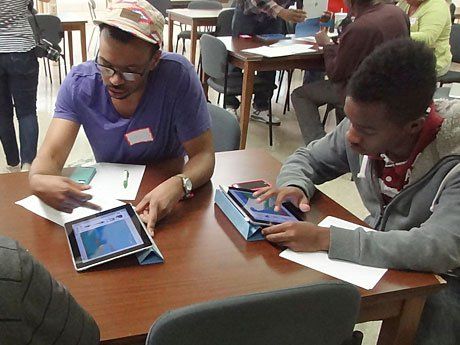
Technological progress is perhaps the most useful avenue for differentiated instruction. Technology programs in classrooms create an individual for each student in the high school setting. Technology allows teachers, instructional coaches, and administrators to keep students in flexible “fluid” groups based on data throughout the year. Computer programs are a great curriculum resource for remediation groups to instruct based on skills, interests, readiness, or by choice. and enrichment in all core curriculum courses. Computer programs are also a great enrichment tool for exposing high level students to rigorous texts. Computer programs can provide immediate feedback to higher order questioning.
It is understood that academic achievement is based on the premises of high test scores, active class participation, and successful completion of final exams and class projects. The online instructional component in many high schools is a wide-spread trend across many cities.
Students and faculty members seem to benefit more from online instruction because of the continuous interaction one-on-one or in a group. The interactive assignments give students feedback without the professor being present.

Instructors can keep contact with the independent variable because the technology tool enables them to view student’s progress. Another reason why it is believed that the students benefited more from online programs because they could always refer to old lessons and practice with feedback.
Academic achievement rates are measured using a percentage of A, B, or C. High school students score significantly higher receiving a percentage of 70 accomplishing a grade of C or higher with online curriculum programs. This percentage was compared to the participants in a traditional paper-based group who scored 49% of a C or higher.
Differentiation through technology promotes individual learning pathways: How standards correlate, the availability of formative assessments, and options of different skill levels on the same content. High school teachers are challenged with various leveled groups. Instructors are faced with students having different reading levels. Teachers must still ensure all students are career and college ready. When working with leveled groups, teachers use websites such as Achieve 3000, Khan Academy, and Newsela.
- NewsELA
NewsELA allows students to read the same current events content, but it is differentiated to fit the needs of the specific student. Teachers assign, or students choose articles by subject, Common Core Standard, or Lexile level. Each article has five different Lexile levels that range from grades 3-12.
- Khan Academy
Khan Academy is an online classroom. One benefit from KA is having more class time for student-centered learning. On Khan Academy an instructor teaches each lesson content. The instructor models instruction on a white board and provides follow up lessons to check for mastery. Teachers can upload video from other resources for various I Do, You Do, We DO opportunities. Students are assigned videos and appropriate questions. As students watch the videos and answer questions, the teacher can track their progress.
- Achieve 3000
Achieve 3000 enables the benefits of a blended learning approach in the high school setting. Achieve 3000 differentiates lessons at 12 levels of English. All learners engage in lessons at their individual reading levels accelerated reading gains, boosting mastery of Common Core Standards. Achieve 3000 is a technology-based reading comprehension program that focuses on specific needs of students to provide reading material at each student’s reading level.
The Future is Embedded in the Present. Educators improve the educational skills level of as many students as possible utilizing technology. Differentiated instruction to increases students’ knowledge and skill sets. In turn, students will use the knowledge gained from individualized instruction to develop strategies college and career readiness. I realize that Technology can shape the minds of young people and to help stimulate an interest in education, reading, and world events.
References
Coley, R. (1997). Technology’s impact: A new study shows the effectiveness—and the limitations—of school technology. Retrieved from http://www.electronic-school.com./0997f3.html.
Cornish, Edward (2004) The Exploration of the Future. United States of America, World Future Society.
Healy, J.M. (1998). Failure to connect: How computers affect our children’s minds- For better and worse. New York: Simon & Schuster.
Maeng, J. (2017). Using Technology to Facilitate Differentiated High School Science Instruction. Research in Science Education. Retrieved from http://link.springer.com.
Johnson, D. (1996). Evaluating the impact of technology: The less simple answer. The Educational Journal Vol 5 no5 January/February 2006.
Naisbitt, J. (2006). Mind Set! Reset your thinking and see the future. NY:HarperCollins Publishers.
Stern, J. (2015). Enhancing Learning Through Differentiated Technology:Instruction. Research in Science Education. Retrieved from http://edutopia.org.
Tapscott, D. (1998). Growing up digital: The rise of the Net generation. New York. McGraw-Hill.
.